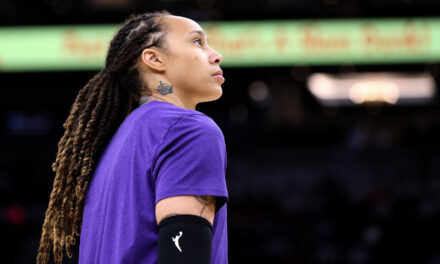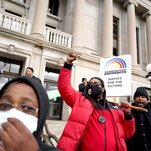
13 Key Moments That Shaped the Trial of Derek Chauvin
In the three weeks of the trial of Derek Chauvin, dozens of witnesses have testified; hours of video of George Floyd’s arrest have been played, paused and replayed; and two sides of the courtroom have presented opposing narratives to a jury tasked with determining the guilt or innocence of a former police officer charged with murder in one of the most watched trials in decades.
Through witness testimony, several distinct themes have emerged as the most crucial points of contention: whether Mr. Chauvin violated policy when he knelt on George Floyd’s neck for nine and a half minutes; what role, if any, drugs played in Mr. Floyd’s death; and what kind of impact the arrest may have had on the people who witnessed it.
These themes became clear almost immediately, in tearful testimony from bystander witnesses and criticism of Mr. Chauvin from experts called by the prosecution. In the final days of the trial, the defense brought the opposite account to the stand, giving the former police officer some support after more than two weeks of almost entirely critical testimony.
The trial, and its looming verdict, has attracted more attention than almost any other criminal proceeding in decades, and as it moves into the final phase — closing arguments on Monday, followed by jury deliberations — these key moments illustrate some of the themes that will be most important to jurors next week.
In the first week of the trial, many of the witnesses who were called by the prosecution had seen the arrest of George Floyd in person. Their testimony gave jurors a clearer view of the final moments of Mr. Floyd’s life, and demonstrated just how jarring seeing the arrest firsthand had been. Several witnesses cried as they recounted the arrest; some said they felt guilty for not intervening, and that they knew Mr. Floyd had been in grave danger. Their accounts set the tone for the rest of the trial and showed how widespread the impact of Mr. Floyd’s death has been.
Darnella Frazier was 17 when she took a video of the arrest that helped prompt a wave of protests across the country. Ms. Frazier was one of a handful of young witnesses who testified off camera. On May 25, she arrived at the Cup Foods convenience store with her 9-year-old cousin. “It seemed like he knew it was over for him,” she said of Mr. Floyd. “He was terrified.”
Charles McMillian, another bystander witness, talked with Mr. Floyd as he was being pinned by Mr. Chauvin. Mr. McMillian told the jury that he had urged Mr. Floyd to get up and get in the police cruiser. “Once the police get the cuffs on you, you can’t win,” he said during his testimony. Mr. Floyd, held to the ground by Mr. Chauvin, replied that he couldn’t.
Mr. McMillian, 61, broke down in tears on the stand, and the court took a short break as he recovered. His testimony, perhaps more than any other, showed just how painful it was to see the arrest in person. Particularly traumatic for Mr. McMillian was the fact that Mr. Floyd called out, “Mama,” in the few minutes before he lost consciousness.
Courteney Ross, who dated Mr. Floyd for nearly three years before his death, gave the jury and the public a rare glimpse into the life and personality of Mr. Floyd. Ms. Ross talked about their relationship, their first kiss, how Mr. Floyd loved to eat and how he helped her explore the city of Minneapolis. Both sweet and tragic, her testimony humanized Mr. Floyd in a way that jurors had not heard up to that point. Ms. Ross also talked about a primary issue in the case: Mr. Floyd’s drug use.
The defense has argued that Mr. Floyd died largely from complications of drug use, rather than as a result of being held down by Mr. Chauvin. Ms. Ross said the couple had struggled with opioid addiction. She said that, like many Americans, their drug use began with legal prescriptions for chronic pain. “We got addicted,” she said, “and we tried really hard to break that addiction many times.”
By the time paramedics arrived, Mr. Floyd had been unresponsive for several minutes, still pinned under the knee of Mr. Chauvin. Derek Smith, one of the paramedics who responded to the scene, testified that he looked for Mr. Floyd’s pulse almost as soon as he arrived, but found none. “In lay terms, I thought he was dead,” Mr. Smith said.
His testimony gave jurors a clearer understanding of what happened in the minutes after the arrest, and of the efforts made to save Mr. Floyd’s life on the way to the hospital. Despite his efforts, which included using a defibrillator and a machine that provides chest compressions, Mr. Smith said he could not revive Mr. Floyd. The police officers who arrested Mr. Floyd provided no medical care at the scene, even after one officer failed to detect a pulse.
In a rare condemnation of an officer by an acting police chief, Chief Medaria Arradondo of the Minneapolis Police Department testified that Mr. Chauvin violated police policy when he knelt on Mr. Floyd for more than nine minutes. “Once Mr. Floyd had stopped resisting, and certainly once he was in distress and trying to verbalize that, that should have stopped,” the chief said.
Chief Arradondo said Mr. Chauvin also violated policy by not providing medical aid to Mr. Floyd once he became unresponsive. Whether Mr. Chauvin violated policy will most likely be a central question for the jury, and a rebuke from the acting police chief may prove a substantial blow to Mr. Chauvin’s defense.
Throughout the trial, Eric J. Nelson, the defense attorney for Mr. Chauvin, has suggested that the crowd of bystanders may have made it more difficult for Mr. Chauvin to render aid or to move Mr. Floyd from the prone position. Police Officer Nicole Mackenzie, who trains Minneapolis police officers on providing medical care, conceded during cross-examination that bystanders can make it harder for officers to see signs of distress in people who are in custody.
Officer Mackenzie’s testimony could lend support to the defense’s argument that other factors were at play, and that jurors should view the situation in context. The crowd of about a dozen people yelled at the officers and urged Mr. Chauvin to move his knee, though they were otherwise peaceful and did not attempt to intervene.
Several law enforcement officials testified that Mr. Chauvin acted outside the bounds of normal policing by restraining Mr. Floyd in a prone position for more than nine minutes. Sgt. Jody Stiger, a use of force expert with the Los Angeles Police Department, told jurors that Mr. Chauvin should have ceased using force once Mr. Floyd was restrained.
Sgt. Stiger said Mr. Chauvin may have been justified in using some force, like a Taser, earlier in the arrest, when Mr. Floyd resisted as officers tried to put him in a squad car. But once he was on the ground, the force should have stopped, the sergeant said, further bolstering prosecutors’ claim that Mr. Chauvin’s force was excessive. He added that being handcuffed and in a prone position can make it harder to breathe, and that the weight of an officer “just increases the possibility of death.”
Arguably the most important question in this case is what caused Mr. Floyd’s death. The prosecution has maintained that Mr. Floyd died from asphyxia, or the deprivation of oxygen, and has called several expert witnesses to support that notion. Dr. Martin J. Tobin, a pulmonologist and a world-renowned expert on breathing, agreed, saying that Mr. Floyd died from a lack of oxygen imposed by the restraint.
In his testimony, Dr. Tobin broke down the arrest in vivid detail, even identifying what he believed to be the exact moment that Mr. Floyd died.
Dr. Tobin said he saw no evidence of an overdose, striking a blow to the defense’s contention that drugs played a primary role in Mr. Floyd’s death. In nuanced testimony, Dr. Tobin counted Mr. Floyd’s breaths and said that he was breathing at a regular rate in the minutes before he died. Had he been suffering an overdose, Dr. Tobin said, the rate of breath should have slowed.
Though regular in interval, the breaths were not deep enough to sustain life, Dr. Tobin said. He was one of several expert witnesses who testified they saw no evidence of an overdose.
Dr. Bill Smock, a surgeon for the Louisville Metro Police Department, also testified that Mr. Floyd died from a lack of oxygen. “He gradually succumbed to lower and lower levels of oxygen till it was gone and he died,” Dr. Smock said.
Though a toxicology report found fentanyl and methamphetamine in Mr. Floyd’s system, Dr. Smock said Mr. Floyd’s behavior did not correspond with that of a typical fentanyl overdose victim. Had he overdosed on fentanyl, Dr. Smock said, Mr. Floyd most likely would have slipped out of consciousness without a fight. Instead, Mr. Floyd yelled and begged for air.
Mr. Nelson, the attorney leading Mr. Chauvin’s defense, has argued throughout the trial that other factors, including drug use and an underlying heart condition, led to Mr. Floyd’s death. But witness after witness called by the prosecution disputed that claim, saying they saw no evidence of a drug overdose and that Mr. Chauvin’s restraint of Mr. Floyd was potentially life-threatening.
One witness, called by the defense, said the opposite. Dr. David Fowler, the former chief medical examiner for the state of Maryland, said he saw no evidence that Mr. Chauvin’s knee hurt Mr. Floyd in any way. His testimony followed that of another expert witness for the defense, who testified that Mr. Chauvin acted within the bounds of normal policing when he held Mr. Floyd in the prone position for nine-and-a-half minutes.
Dr. Fowler and Barry Brodd, a use-of-force expert called by the defense, were the first and only witnesses to offer Mr. Chauvin such unequivocal support.
Both men faced tough cross-examination, though, and prosecuting attorneys scored several key points during their testimonies. Dr. Fowler admitted Mr. Floyd should have been given medical attention, and said that the sudden cardiac arrest that he believes killed Mr. Floyd could have been reversible.
The use-of-force expert called by the defense faced similar struggles during cross-examination. Mr. Brodd, a former police officer, at first said Mr. Chauvin’s restraint did not even qualify as a “use of force,” but then conceded that, under the policies of the Minneapolis Police Department, it did. He also agreed when prosecutors asked whether the level of force should change depending on how much a suspect is resisting; Mr. Chauvin continued to hold his knee on top of Mr. Floyd for several minutes after he became unresponsive.
One of the most important questions in the trial was answered on Thursday, when Mr. Chauvin said he would invoke his Fifth Amendment right not to testify. Though his actions set off a national reckoning over the intersection of race and policing, the public has heard little from the former officer.
Testifying could have been a risk for Mr. Chauvin. Prosecutors showed their prowess during cross-examinations of Mr. Brodd and Dr. Fowler, the two expert witnesses called by the defense. Had he taken the stand, Mr. Chauvin could have opened himself up to a similar level of criticism.
During opening statements, the defense told jurors that this case was about much more than the videos. Yet, witness after witness returned to the videos as they recounted their experiences, debated the details of Mr. Floyd’s last moments, and weighed the question of what caused his death. In closing arguments on Monday, both sides will have one final chance to persuade the jury of their version of the story.


















